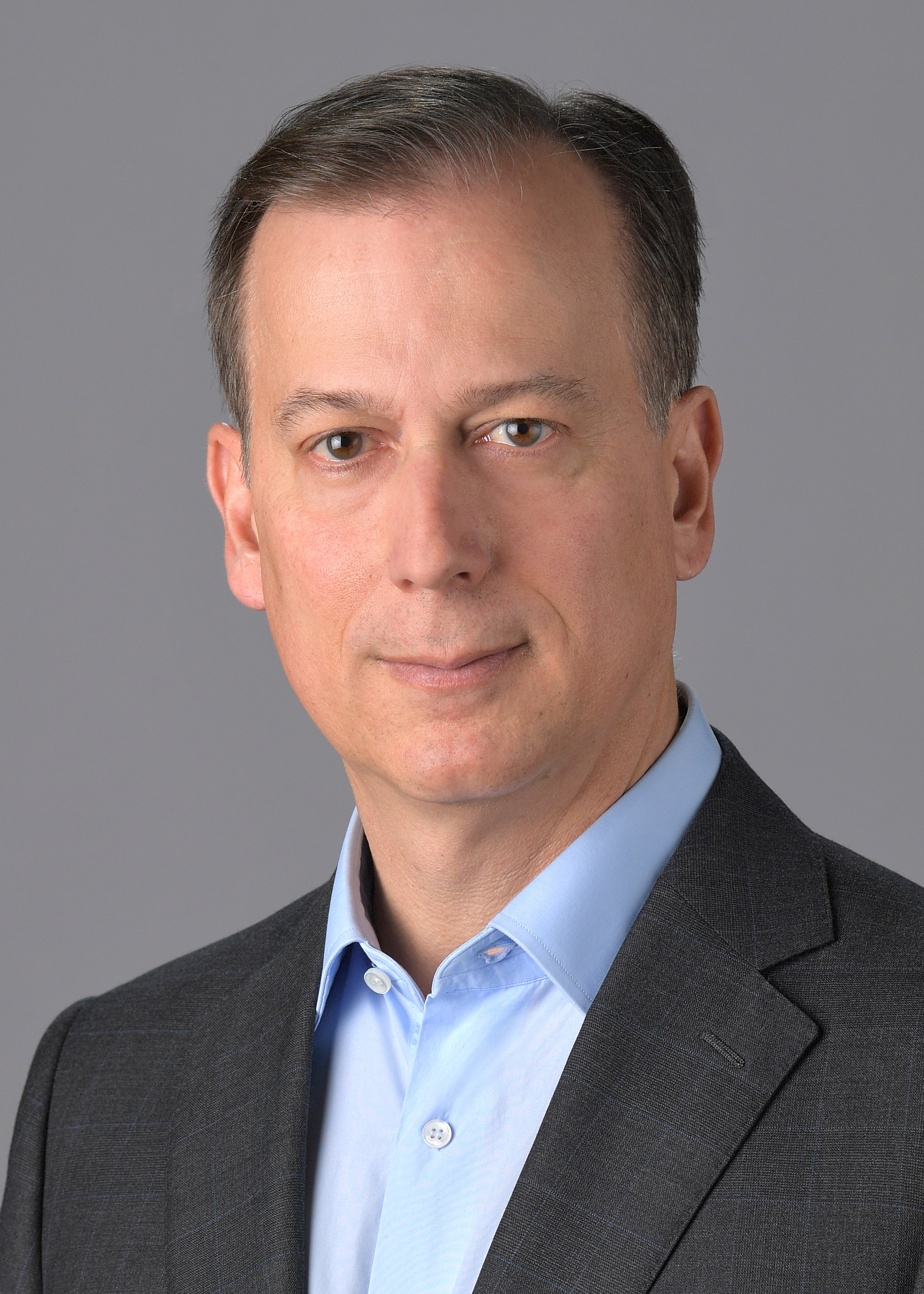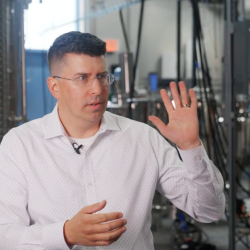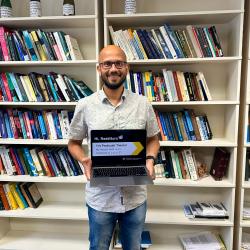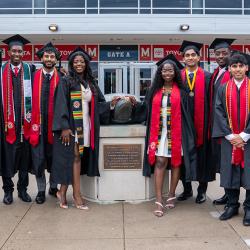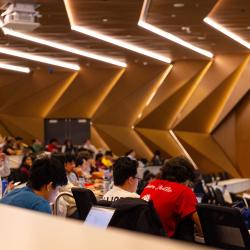From a Passion for Science to a Successful Career in Biopharmaceutical Research
Michael Severino, M.D., has spent his professional life looking for answers—the kind of answers that can be life-changing for patients with HIV, cancer, and countless other life-threatening diseases and chronic conditions. For Severino (B.S. ’87, biochemistry), the work is more than a challenge, it’s his passion.
“It’s what drives me,” Severino explained. “In my mind, you have to be passionate about something to succeed in it. And you have to work hard and those go hand in hand. The greatest days of my career are the days when we open the metaphorical envelope and we’re amongst the first people in the world to know the answer to a question about how we treat a disease.”
Severino has made his mark as a leader in biopharmaceutical research. He is currently vice chairman and president at AbbVie, a Fortune 100 company and one of the largest pharmaceutical companies in the world.
“I’m very fortunate to be able to do something that I really love for a living,” he said.
For Severino, the path to becoming a physician-scientist was clear early on. As a boy growing up in Colesville, Maryland, he read every science book he could get his hands on, even turning to his college-age sisters for their help when he ran out of options at the public library.
“I have two older sisters who both went to the University of Maryland, and one of my sisters would take me to the University of Maryland library to try and find more material to read,” Severino recalled. “I essentially always knew that I would pursue a career in science in one form or another. I could never really imagine doing anything else.”
When Severino entered the University of Maryland in 1984 he briefly considered studying mathematics or physics, but quickly realized chemistry could take him where he wanted to go.
“I entered UMD as a chemistry/biochemistry major,” Severino said, “They were essentially the same major with one course differentiating your degree: whether you took advanced inorganic chemistry or 400-level biochemistry. I decided to take the biochemistry degree because, at that point, I knew I was going to go into life sciences. I knew it was going to be a better fit.”
Placing out of the freshman chemistry classes, Severino soon found himself in the chemistry department’s honors program—which he now realizes was an extraordinary learning opportunity. He loved every minute of it.
“The chemistry honors program was just an incredible program,” he recalled. “The principal benefit was your own track for all of the courses. In most places, including the top Ivy League institutions, organic chemistry was a lecture hall course with 250 people. My organic chemistry class was eight of us and a full professor where we met around the conference table in the reading room by his lab. And he drew on the white board and taught us organic chemistry. I didn’t really fully appreciate how rare that was at the time.”
But what may have made an even bigger impact was Severino’s first real lab experience. Working in former UMD Professor John Kozarich’s lab every semester and every summer, he discovered a passion for research.
“We were trying to trap transition-state intermediates of an anaerobic enzyme involved in metabolism,” Severino explained. “I was making these suicide inhibitors for phosphate compounds whose principal application was as pesticides that are basically toxic as all get out. So, I would get all my syntheses from these agricultural chemistry journals about the synthesis of pesticides then I would go make them in the hood. It was a lot of fun, a great experience in the lab. John was just a great mentor.”
As he entered his senior year at Maryland, Severino was well on his way toward a research career in the life sciences. By the time he graduated in 1987, he had already been accepted to Johns Hopkins University for medical school.
“At that point, I knew I was going to pursue a career as a research physician, as a physician-scientist,” Severino recalled. “I loved the research, but I was always drawn to the relevance and application to patient care and that’s why I chose that path. I continued my research interests in immunology and dual-tracked my research with a traditional medical school curriculum.”
“I never wanted to do anything halfway”
After earning his medical degree, Severino went on to complete his residency and fellowship training at Harvard Medical School.
“I trained at the Massachusetts General Hospital in Boston, and it was a very, very rigorous program,” Severino said. “I chose that on purpose because I never wanted to do anything halfway.”
The work was challenging, and often exhausting. Severino expected nothing less.
“There were times when I worked 120 hours a week,” he explained. “There are 168 hours in a week; I know that because I spent most of them in the Massachusetts General Hospital. And I loved it. I think about it as one of the best times of my life. When I ran the ICU as a senior resident, that’s when you work the absolute most. Did I love every second of it? Absolutely. And you can’t do that if you don’t love what you’re doing.”
“We’ve got to find a way to do better than this”
It was during his time at Massachusetts General Hospital that Severino had an experience he can’t forget: one that reminded him of the reason he chose to dedicate himself to a career in research.
“It was around 3 a.m.,” Severino recalled. “I had worked on a patient and I was writing my assessment and what I was going to do, and I remember just thinking, ‘You know, the intervention that I’m recommending, the effect is just very small. It’s the best we can do, but we’re really not doing what we want to do for these patients. We’re not able to help them in the way that we’d all like to be able to help them.’ I always knew I’d go into research, but this was a moment when I realized we’ve got to find a way to do better than this. We’ve got to be able to find interventions that make a bigger impact.”
Severino was still working as a researcher in Boston in 1998 when an opportunity at Merck caught his attention.
“I really wanted to change the way diseases are treated,” Severino said. “I have tremendous respect for the academic research model, but that’s a very, very challenging thing to do from an academic research lab. I realized that by moving to Merck I could actually have much greater impact.”
Severino spent more than five years at Merck doing just that, advancing research on infectious diseases, oncology and diabetes. Then, in 2004, he moved on to another major multinational pharmaceutical company, Amgen, where he spent nearly a decade, leading the company’s early development efforts in immunology and later directing clinical research as chief medical officer.
An opportunity he couldn’t pass up
In 2011, Abbott Laboratories, a multinational medical device and health care company, announced it would split into two separate companies. One of them, a new independent research-based biopharmaceutical company AbbVie, officially launched in 2013. Severino joined AbbVie soon afterward—it was an opportunity he couldn’t pass up.
“It was a unique opportunity because it was a company that was crafting its identity as an innovation-driven biopharmaceutical company that wanted to pursue science-based solutions to really challenging medical problems—cancer, autoimmunity, chronic hep[atitis] C—and it was really dedicating itself to that innovative model,” Severino said. “In my mind, it was the best of both worlds. It was a large, fully enabled company with an eye toward innovation and novel research-based solutions for patients.”
Coming in as the head of research and development for AbbVie, Severino saw a rare opportunity to do something he’d pursued from the start—make the kind of impact that can change lives.
“At AbbVie we have a collective mission to make a remarkable impact, and that’s what we’re striving for,” Severino explained. “We’re not striving for something that is just a tiny bit better than before. We’re trying to find something that’s dramatically better. I think one example would be the work we’ve done with hep[atitis] C. When I was training, we didn’t even know what virus caused hep-C. Ultimately, we produced a regimen that cured 98% of subjects in eight weeks. So, you go from an incurable lifelong illness that had significant risk of hepatic failure, liver cancer and death to something that can be cured with eight weeks of therapy with 98%. That transformation is something that was hard to imagine even a decade earlier.”
In 2020, AbbVie launched a $30 million research alliance to fight viral infections, like the novel coronavirus tied to the COVID-19 pandemic.
“There is much to learn about viral diseases and the best way to treat them,” Severino said in the announcement. “By harnessing the power of collaboration, we can develop new therapeutics sooner to ensure the world is better prepared for future potential outbreaks.”
With every challenge, Severino sees an opportunity to make a difference.
“Seeing what the field can do and seeing what we can do as a company, it’s what I want to do,” Severino said. “This company is built on our experience initially in autoimmune diseases. Our medicines have been used to treat millions of patients suffering from autoimmune diseases and when you look at the ability to make that kind of impact, that’s what drives us.”
And even in those times when he’s not at work, chances are he’s thinking about it.
“I spend time with my family and they keep me grounded,” he explained. “I’m an avid cyclist and a skier, too. Those are the only times that I’m not thinking about work—well, except when I’m talking to my wife and my kids. But work is always in the background in my brain.”
It was more than 30 years ago that Severino made the decision to turn his passion for science into a career in research. And he’s never regretted it. But he’s not done yet.
“When I think about how far science has come in the last 10 or 20 years, then I think about what it will be in the next 10 or 20 years, knowing that and being able to apply that and being able to drive that is what I want to do. I don’t really know what else I would do with my life,” Severino said. “The scientific draw of what we do, coupled with the favorable impact on patients’ lives makes this just a remarkable way to spend your career.”
###
Media Relations Contact: Leslie Miller, 301-405-9267, lmille12@umd.edu
University of Maryland
College of Computer, Mathematical, and Natural Sciences
2300 Symons Hall
College Park, Md. 20742
www.cmns.umd.edu
@UMDscience
About the College of Computer, Mathematical, and Natural Sciences
The College of Computer, Mathematical, and Natural Sciences at the University of Maryland educates more than 9,000 future scientific leaders in its undergraduate and graduate programs each year. The college's 10 departments and more than a dozen interdisciplinary research centers foster scientific discovery with annual sponsored research funding exceeding $200 million.


